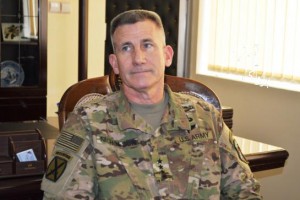NATO’s Resolute Support (RS) Commander Gen. John W. Nicholson has said almost 70 percent of fighters in the Islamic State (IS) group in Afghanistan are former Pakistani Taliban.
Dawn.com said Nicholson told journalists in Washington that a dozen terrorist groups were still operating in Afghanistan despite the 15-year-old engagement of the US and NATO forces.
“In the case of Islamic State Khorasan province, the majority of the members are from the Tehreek-i-Taliban Pakistan (TTP),” the general told journalists at the Pentagon earlier this week.
He explained many of these terrorists were forced out of Pakistan by the Zarb-i-Azab military operation and most of them came to Nangarhar province from Pakistan’s Orakzai tribal agency.
“And they were former members of the TTP, complete with their leadership, who wholesale joined Islamic State, pledged bayt (allegiance) to Islamic State and joined them earlier this year,” he said.
He said 70pc, roughly, of those fighters were from the banned TTP and many of them were Pakhtuns from Orakzai.
Gen Nicholson said the IS, also known by Arabic acronym Daesh, militants were exporting their radical ideology from their bases in Iraq and Syria to Afghanistan and other countries in the region.
“Daesh is only one of nine US-designated terrorist organisations here in Afghanistan,” he said. “Additionally, there are three other violent extremist organisations.”
The Air Force Times reported on Friday that since last month there had been a dramatic increase in the US air strikes on militant targets in Afghanistan.
“Strikes against Afghan targets hit a 2016 high this month, specifically between July 19 and 25, when more than 70 munitions were employed,” Lt Col Chris Karns, spokesman for the US Air Forces Central Command, told the newspaper. F-16s, MQ-9s and B-52s conducted most of the operations.
“These groups are the principal focus of our counterterrorism mission,” Gen Nicholson said, adding that besides Daesh and the Afghan Taliban, the Pakistani Taliban and the Islamic Movement of Uzbekistan were also operating. Some fighters from both groups have now migrated over to join Daesh.
Gen Nicholson said Daesh was involved in last Saturday’s attack in Kabul that left more than 80 civilians dead.
He said Daesh previously controlled around 10 districts in Nangarhar in December last year, but since January, when President Obama authorised US forces to participate in counterterrorism attacks, the group has been forced to retreat from some of the areas.
Gen Nicholson said the increasing influence of Daesh in Afghanistan had also led to clashes between them and the Afghan Taliban, contributing to Daesh’s retreat from some areas. “So, now since January, their area has shrunk to…parts of three or four districts in southern Nangarhar.”
He said the US forces were now working with Afghan security forces to reclaim significant portions of the territory that was previously controlled by Daesh. Many Daesh commanders and soldiers were killed in these joint operations and their key infrastructure capabilities and logistical nodes were destroyed, he added.
“Daesh fighters are retreating south into the mountains of southern Nangarhar. We will continue to stay after Daesh until they are defeated here in Afghanistan,” Gen Nicholson said.
He explained that this “critical fight” was part of a larger global strategy against the IS and coincided with ongoing operations in Iraq and Syria.
He said there were an estimated 3,000 IS fighters in Afghanistan in January, many of them members of other terrorist groups that changed allegiance.
pajhwok.com



